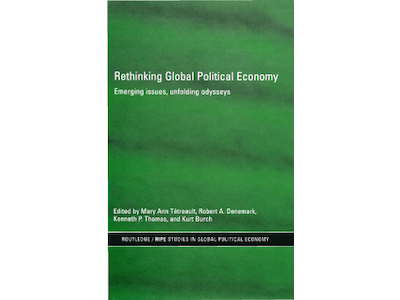Mergers, Stagflation and the Logic of Globalization
Nitzan, Jonathan.
(2003).
In Rethinking Political Global Economy. Emerging Issues, Unfolding Odysseys.
Edited by Tétreault, Mary Ann and Denemark, Robert A. and Thomas, Kenneth P. and Burch, Kurt.
RIPE Studies in Global Political Economy.
Routledge / RIPE Studies in Global Political Economy, pp. 109-146.
(Book Chapter; English).
![[thumbnail of 030101N_Merger_stagflation_and_the_logic_of_globalization_front.jpg]](/166/2.hassmallThumbnailVersion/030101N_Merger_stagflation_and_the_logic_of_globalization_front.jpg)  Preview |
Cover Image
030101N_Merger_stagflation_and_the_logic_of_globalization_front.jpg Download (75kB) | Preview |
Preview |
PDF (Full Text)
030101N_Merger_stagflation_and_the_logic_of_globalization.pdf Download (1MB) | Preview |
Abstract or Brief Description
The chapter offers a new approach for analysing capitalist development and crisis, tying together mergers and acquisitions, stagflation and globalization as integral facets of accumulation. The framework builds on the concept of differential accumulation, emphasizing the power drive by dominant capital groups to beat the average and exceed the normal rate of return. Four regimes of differential accumulation are articulated: internal breadth by amalgamation, external breadth through green-field investment, internal depth via cost-cutting, and external depth through stagflation. The complex relationships between these different regimes, as well as their broader societal implications, are analysed in light of the US experience over the past century. Several broad conclusions emerge. (1) Of the four regimes, the most important are amalgamation and stagflation, which tend to oscillate inversely to each other. (2) Over the longer haul, amalgamation grows exponentially relative to green-field investment, contributing to the stagnation tendency of modern capitalism. (3) The wave-like pattern of mergers and acquisitions reflects the progressive break-up of socioeconomic ‘envelopes’, as dominant capital moves through successive amalgamation at the industry, sectoral, national, and, finally, global level. In this sense, the current global merger wave is an integral facet of differential accumulation. (4) Periodic lulls in amalgamation tend to be compensated for by stagflation, which appears as a crisis at the societal level, but which contributes significantly to differential accumulation at the disaggregate level. An end to the present worldwide merger boom could therefore trigger global stagflation. (5) Stagflation crises have been previously 'resolved' when dominant capital broke its existing envelope, pushing to amalgamate within a broader universe of takeover targets. Given that there is nothing more to conquer beyond the global envelope, future stagflation crises may prove much more difficult to tame.
Language
EnglishPublication Type
Book ChapterKeywords
accumulation acquisitions breadth capital capitalism centralization competition conflict conglomeration corporation crisis depth differential accumulation distribution finance globalization growth institutionalism IPE liberalization M&A merger ownership politics power profit ruling class sabotage stagflation state stock market technology TNC United States US violence warSubject
BN TheoryBN State & Government
BN Cooperation & Collective Action
BN Industrial Organization
BN Institutions
BN Power
BN International & Global
BN Region - North America
BN Business Enterprise
BN Value & Price
BN Crisis
BN Production
BN War & Peace
BN Money & Finance
BN Conflict & Violence
BN History
BN Ideology
BN Methodology
BN Distribution
BN Agency
BN Capital & Accumulation
BN Policy
BN Class
BN Growth
Depositing User
Jonathan NitzanDate Deposited
09 Feb 2007Last Modified
31 Mar 2016 22:00URL:
https://bnarchives.net/id/eprint/166Actions (login required)
 |
View Item |
